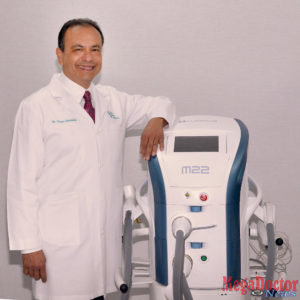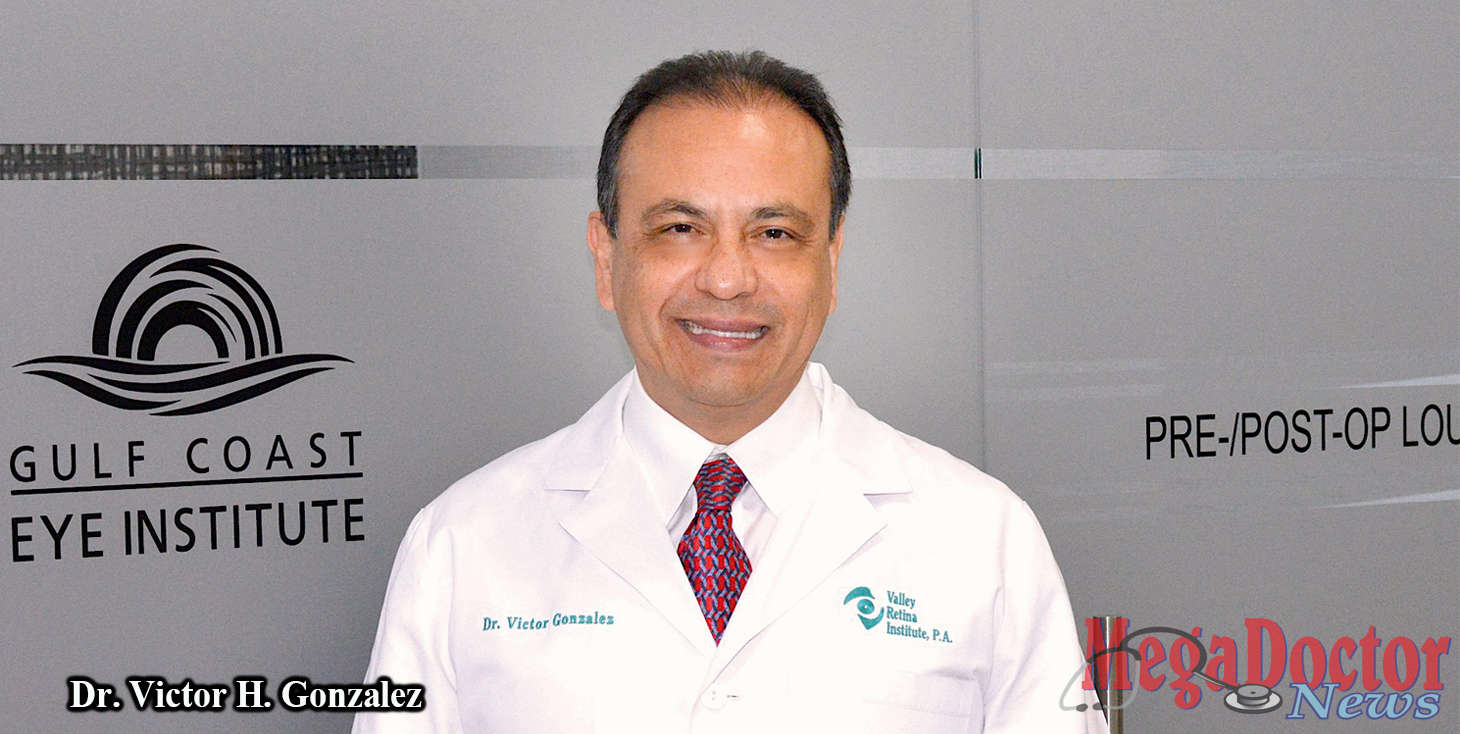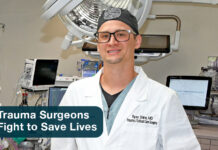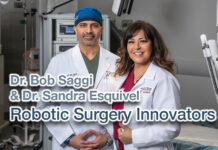Mega Doctor News
By Roberto Hugo Gonzalez
As originally published by Mega Doctor News newsprint edition December 2019
In the past, eye diseases were the end of the freedom of an individual. Imagine having cataracts, glaucoma, or a detached retina, causing impossibility for you to walk, drive, or even have fun with your family. Without a doubt a big problem, it would make people handicap and forced to rely on other people to move around.
Because there are important questions to ask concerning your eyes, we selected Dr. Victor H. Gonzalez. An ophthalmologist with a subspecialty in vitreoretinal medicine. Diagnosis and treatment of macular degeneration, diabetic retinopathy, and other eye problems, a daily routine in his practice.
We wanted to learn about his profession and for him to tell us about the dangers that our eyes face as we grow older. Your precious eyesight deserves proper care and professional advice.
An ophthalmologist is one that diagnoses and treats eye diseases, including vision loss, detached retinas, cataracts, and glaucoma. They also perform laser retina surgery, refractive surgery, and lens replacement operations.
Dr. Gonzalez is a brilliant, well-trained physician; South Texas is fortunate to have him here. He egressed from among the best and most prestigious medical schools in the United States.
He graduated with honors from Harvard Medical School in 1988, now with more than 31 years of experience in his field.
Dr. Gonzalez is a National Board of Medical examiners member, and a Diplomate of the American Board of Ophthalmology.
Considering that the eyes are the body’s most highly developed sensory organs, and a more significant part of the brain is dedicated to vision than hearing, taste, touch, or smell combined. Sometimes, we take for granted our eyesight. Yet, when vision problems show up, we do everything in our power to restore our sight.
“I grew up in Los Angeles and attended school in Huntington Park, California, a suburb of Los Angeles,” he told Mega Doctor News.
He attended Princeton University for four years of college, majoring in chemistry. “I decided that I wanted to go to medical school and was fortunate enough to get into Harvard Medical School in Boston, Massachusetts.”
After graduation from Harvard, he went back to Los Angeles, California, to reconnect with family after eight-year being away.
Dr. Gonzalez’ Postgraduate training, Internship– Cedar Sinai medical center, Los Angeles, CA, Residency – Doheney Eye Institute and Los Angeles County Hospital, University of Southern California Medical Center.
He returned to Boston and did his Fellowship in Vitreal Retinal, at Massachusetts Eye and Ear Infirmary, Harvard Medical School, Boston, Massachusetts.
So, there you have it. Four years of college, four years of medical school, one year of internship, three years of residency, and then two years of fellowship. That is why I said we are fortunate to have Dr. Gonzalez.
“This is home for me. I’ve lived in the Valley the longest of any place. When I left for college, I was 17. So, I’ve been here for more than 24 years.”
What attracted him to South Texas is interesting because, during his training, he connected with scientists working on medical solutions now used in the new century.
“When I was training in Boston, I was exposed to one of the premier diabetes centers in the world, the Joslin Diabetes Center. I met mentors important to me.”
One of his mentors was Dr. Lloyd Aiello, Sr., a retina specialist who focused on diabetes at the Joslin Diabetes Center. Dr. Gonzalez pointed out that Dr. Aiello’s introduction impressed him in terms of the problems facing people with diabetes.
But the one that had the most significant impact in terms of seeing what could potentially be done for diabetics was a pediatric surgeon at the Boston Children’s Hospital.
He said, “His name was Dr. Judah Folkman, the one who developed the concept of a chemical messenger that was responsible for controlling and acting upon blood vessels.” He continued, “His focus was in pediatric surgery and oncology.”
According to Dr. Gonzalez, Dr. Folkman, as he was removing tumors in children, he noticed tumors attracting the blood vessels. So, he proposed that there had to be a chemical messenger.
“Dr. Folkman dedicated his life looking for that messenger and found it.” Dr. Gonzalez said, “It turns out to be a universal messenger. A lot of the problems with the retina related to circulation, diabetes, diabetic retinopathy in the eye, occlusions of the vessels in the eye, all these conditions were fueled by this chemical called Anti-VEGF.”

Dr. Gonzalez said that because of Dr. Folkman’s findings, the field of Angiogenesis was born.
He also said that at a very early stage in his career, he was able to see the devastation caused by diabetes. Still, at the same time, he saw the potential for a solution or at least a treatment.
“30 plus years later, aside from controlling your blood sugar levels, blood pressure and all of the metabolic controls, the first line of treatment for diabetic retinopathy, macular degeneration, a lot of retinal vascular conditions are the Anti-VEGF treatments.” He continued, “The concept that was born from findings and dedication of this doctor.”
“So, you asked me why the Valley? Because I researched the area and found that there was a significant incidence of diabetes, and I wanted to go to a place where I could have an impact in terms of my training.
Besides, he also wanted to have an impact in terms of language, Dr. Gonzalez is fully bilingual.
When he was in and New York, and other places, he had great offers. “I’m sure I would have been happy, but I think that I wouldn’t have been as fulfilled as I am because of my opportunity to come to this area.”
He stated that his service and fulfillment is about taking care of patients, to educate and empower them with information so they can take care of themselves. “It has never been just to treat them and send them home.”
The challenges he faces, is the large percentage of Hispanics without insurance, the population that still lives under the poverty level — a large number of patients with advanced problems. “Unfortunately, when I first came here, it was the gamut across the board in terms of the severity. What do I mean by that? Poor health care, malnutrition, pregnant mothers wind up having premature babies, and prematurity brings a lot of complications.” He said, “One of them is in the eye.” “When I first arrive here, there was a high incidence of blindness. It was due to retinopathy of prematurity.”
He attributes the high incidence because there were no full-time trained professionals taking care of these patients.
From his point of view, he feels that a combined effort of professionals has made an essential impact in the Rio Grande Valley.
He mentions that the right new treatments for the more severe complications of retinopathy are also those medications that Dr. Folkman discovered. He also points out that for the adult population that has challenging conditions now are curable and controllable.
He was referring to cataracts, which are one of the most common problems that people come with. “fortunately, we’ve had significant advances in that. So, the only reason why someone has severe problems of vision as a result of cataracts is that they don’t have access to care and no insurance.”
The other disease that he considers a severe problem, is glaucoma in the community.
He explained that glaucoma causes an elevation in the eye pressure, and slowly damages the optic nerve. The advantage here is that if its catch early, there are medications and treatments.
In this case, he said, a lot of the time, glaucoma is asymptomatic. By the time people visit a doctor, they’re very advanced.
“Those are the three most common issues aside from diabetes, diabetic retinopathy. The state guesstimates that about 25% of our population has diabetes in the Valley.” He continued, “By 2050 across the country, peoples of color, Hispanics, African Americans across the board, one out of every two individuals, 50% will have diabetes unless we change the current trends.”
He added that those statistics are a challenge for them from an eye standpoint because diabetic retinopathy is very prevalent but treated, identified, and managed on time is very controlled.
“Close to 25 years, the incidence of blindness from diabetes was dramatic. Since then, with a combination of the team approach, much has changed. He said, “The internist, the endocrinologists, the family practitioners, we’ve all come together and have formed a very elaborate safety net for our diabetics, along with the self-specialist.”
He adds, “The only problem is if the patients don’t come in on time, if they don’t have access, again that’s a challenge.
Part II, a continuation of this article, will be published in a later month. Part II will cover how his mother had a vital role in his education. All his siblings also are highly educated because of her.
It will also include why do people get cataracts? Including his role as chair of a local retina fellowship, and clinical research — his involvement with all the major clinical trials in the country in this regard.
He is a clinical professor at UTRGV in the molecular biology department. And his interaction with the Ph.D.’s and the medical students at UT RGV. He teaches ophthalmology courses. So, stay tuned, always look for Mega Doctor News.




















